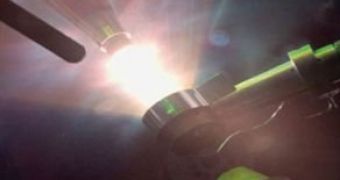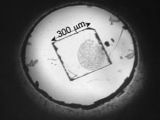Very little is known about how high-temperature gas in a condensed state - such as the one inside giants like Jupiter, Saturn or other gas giant exoplanets in the galaxy - behaves. In order to get a better understanding of the evolution of gases in these exact thermodynamic conditions, a collaboration between the Laboratory of Laser Energetics, CEA France and University of California Berkeley generated an experiment that compressed helium to about 10,000 Earth atmospheres, or 100 GPa, with the help of a high-energy Omega laser.
Previous attempts to determine helium's equation of state at such high temperature and pressure were made by Bill Nellis, albeit those experiments were conducted by using cryogenic techniques and the maximum pressure achieved was only a fraction of that obtained in the latest experiment, 16 GPa. Helium makes up for most of the matter inside a gas giant and while deep inside the planet, it may experience high-temperature superconductivity, superfluidity and Wigner crystallization.
"The state of materials in the center of a giant planet are difficult to observe and challenging to create or predict. Defining the equation of state of helium at these pressures is a first step to deepen our understanding of these massive objects", says Physical Science Directorate researcher Gilbert Collins.
It is believed that the pressure inside gas giants can exceed 100 million times the atmospheric pressure on Earth. By using the Omega laser from the Laboratory of Laser Energetics at the University of Rochester, the team was able to bring the gas to a state of high pressure and density inside a diamond anvil soon after the precompression stage through which the initial density of the material was set.
Shock velocities through a quartz material were used as reference during the measurements conducted on helium, so that any uncertainties could be minimized as much as possible. "By applying a strong shock to a precompressed sample, we can re-create the deep interior states of solar and extrasolar giant planets", explained Collins.
Precompression pressure is regulated through the thickness of the anvil, while sample heating is prevented with the use of a high-energy X-ray absorbent material. Shock velocities were measured with a Velocity Interferometer System for Any Reflector and calibrated in relation to the quartz shock velocities, in order to determine the density and pressure of the precompressed helium.
Once the laser system was brought on line, the helium sample was pressurized to 100GPa, and equation of state data obtained. Alternatively, researchers revealed that while nearing 100GPa, helium experiences a high conductive state thus becoming reflective to the VISAR 532-nanometer laser pulse. The scientists who collaborated on this project are now preparing to recreate the same conditions during the detonation of a nuclear weapon, although extensive studies are required before the National Ignition Facility can initiate the experiment.

 14 DAY TRIAL //
14 DAY TRIAL // 
